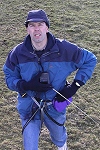
Shale Oil Waste Bing
Philpstoun, West Lothian, Scotland, UK
June 20, 2010, 15:28 U (16:28 local)
© 2010 James Gentles, All Rights Reserved.
At the turn of the 20th Century the discovery of easier to obtain and process “crude” oil meant the industry ended, all that was left was the forgotten red “bings.”
In the 1960s and 1970s the need for large quantities of aggregates for the foundations of Scotland’s motorways made engineers look again at the “bings.” The one at Philpstoun is typical. It was “re-mined” to extract the best shale spoil, which was removed for the new freeways. As well as reducing the overall height of the “bing,” the works resulted in the inside of the hill being turned into a labyrinth of pits, tracks, and mounds where the material has been graded, removed, and in some cases rejected.
Once again, when all the usable material had been extracted the location was forgotten.
In recent times the area has been rediscovered by cross-country motor-bikers and (not necessarily with the land-owners permission) has become a magnet for those wanting a challenging off-road experience.
Finally locals recently campaigned and stopped a planning application to use the site for waste recycling.
How forgotten really is this site, and what does it tell us about peoples attitude to waste, and recycling?
Lat: 55° 58' 23.16" N
Long: 4° 31' 50.65" W
Elevation: ground ~80m, camera ~150m
Precision is: Medium. Nearby, but not to the last decimal.
This technique produces two hemispheres, and a different workflow in PTGui from the classic ground pano technique. This results in lower resolution BUT impossible angles!
See the rig, how Kite Aerial Photography is achieved, and the workflow.
The first trip to shoot had lots of bikes but not enough wind, second trip had neither wind nor bikes, so I took some ground panoramas as "backup". Later that same day the wind was stronger so third time lucky and my biggest kite (for lightest winds) saw us with the kite pulling well.
Once flying I attached the camera that weighs 1.4Kg (3lbs) to the line below the kite then let out more line to raise it into the air. Always a nervous time as the fisheye lens points straight down and has no protection should it touch the ground.
The camera automatically took around 150 images, hopefully you like the results!


 Tap or click the zoom icon in the bottom right corner of the picture to switch between in-page and fullscreen view
Tap or click the zoom icon in the bottom right corner of the picture to switch between in-page and fullscreen view